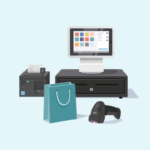What do you get when you combine technological advances with pandemic-accelerated changes in retail shopping behaviors? An evolving point-of-sale (POS) experience that puts the emphasis on customer convenience.
Recent research finds that roughly one-third of American shoppers prefer to shop online, while one-fifth prefer to shop in-store. Almost another third expresses a preference to shop in person but says the convenience of online shopping often wins out. The remaining population – 12 percent – says it’s all the same to them, and they don’t have a preference between online and in-person shopping.
It’s all part of a notable shift in consumer buying patterns driven by increased willingness to shop and buy online across all generations. By far, ease is the driving factor behind the shift, with three POS trends leading the way.
1. Digital payments go mainstream.
It’s official. Digital payments – defined as tap-to-pay cards, digital wallets, and mobile payments – have surpassed cash as the top retail payment method. Today, almost seven in ten retailers offer digital payment options. That’s up from four in ten in 2019. As a result, contactless payments – whether by card or digital wallet – increased for 69 percent of retailers in 2020. And in-store use of digital wallets nearly doubled, going from 12 percent to 23 percent during that time.
The rapid consumer adoption rate is projected to continue, with the number of digital wallet users doubling by 2025. That means offering digital payment options is quickly moving from a nice-to-have to a must-have for retailers. When their preferred payment option isn’t available, 42 percent of customers say they won’t go through with a purchase.
Choose a POS system that enables you to offer a wide range of payment processing options, including digital, while also ensuring payment security aligned with the Payment Application Data Security Standards (PA-DSS) on how customer payment data is accepted, processed, and stored.
Related: The Top 5 Things You Need in a POS System
2. Buy now, pay later options deliver added flexibility.
Along with options for how they pay, shoppers also want choices for when they pay. Once reserved for big-ticket purchases, buy now, pay later (BNPL) options are now being offered more broadly by retailers. By choosing to buy now, pay later, customers can purchase an item and pay for it later or over a defined period of time. Typically, BNPL purchases don’t incur additional charges or fees as long as payment is complete by a designated date.
Customers appreciate the flexibility. In 2021, 56 percent of consumers have used BNPL – up significantly from 38 percent in 2020. And more than half of non-users say they’re likely to opt for BNPL within the next year. Along with providing added customer convenience, BNPL pays off for retailers. Research shows that when retailers offer a BNPL option, they can increase new customers up to 80 percent while lowering return rates by up to 18 percent.
Your POS system is key to capitalizing on the BNPL trend. Look for capabilities that enable and streamline in-house accounts, payments on account, recurring billing, and finance charges.
Related: 8 Ways to Put the Wow in Your Point-of-Sale Experience
3. Buy online, pick up in-store continues to gain popularity.
Sixty-eight percent of shoppers had elected to buy online and then pick up their items in-store or curbside – known as buy online, pick up in-store (BOPIS) as of 2019. Then, the option’s popularity really took off during the pandemic, with usage spiking almost 400 percent. Looking ahead, customers plan to keep using the convenient option.
For shoppers, BOPIS offers the shop anytime efficiencies of online shopping with the convenience of same-day access and no shipping fees. For retailers, 85 percent of shoppers report buying additional items when they opt for BOPIS.
Having a POS system that integrates online and in-store data is an essential element in optimizing BOPIS services. In addition, make sure your system includes mobile POS options so that sales associates can access the platform via smartphone or tablet from anywhere in the store or curbside.
POSIM is a point-of-sale and inventory management system that offers the payment flexibility and purchasing ease today’s customers expect. Discover what’s possible with POSIM. Contact us for a demo today.












